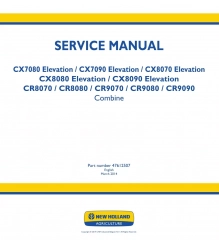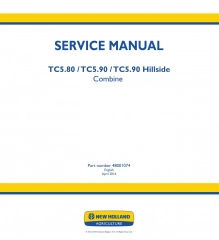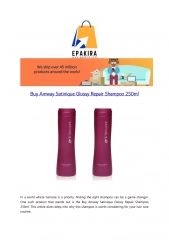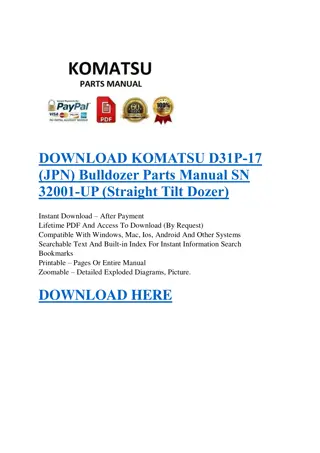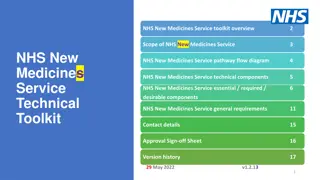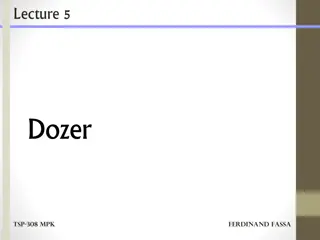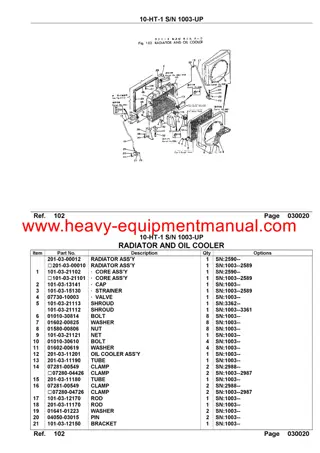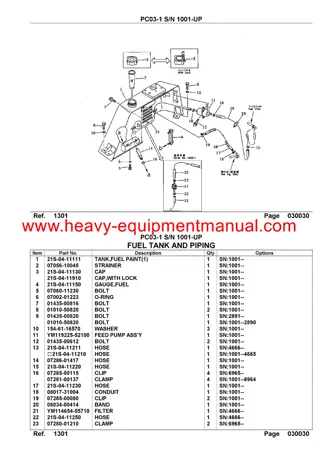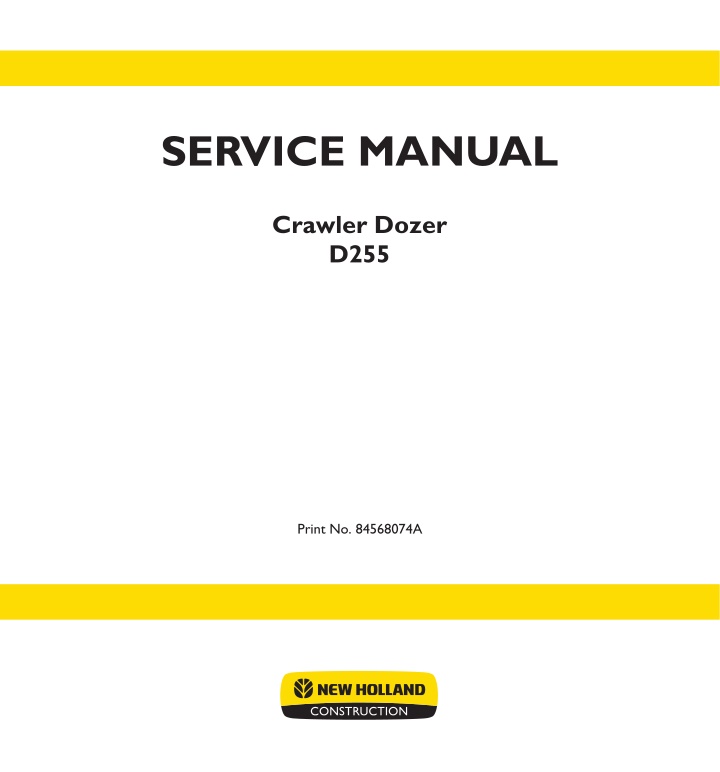
NEW HOLLAND D255 CRAWLER DOZER Service Repair Manual Instant Download
NEW HOLLAND D255 CRAWLER DOZER Service Repair Manual Instant Download
Download Presentation

Please find below an Image/Link to download the presentation.
The content on the website is provided AS IS for your information and personal use only. It may not be sold, licensed, or shared on other websites without obtaining consent from the author. If you encounter any issues during the download, it is possible that the publisher has removed the file from their server.
You are allowed to download the files provided on this website for personal or commercial use, subject to the condition that they are used lawfully. All files are the property of their respective owners.
The content on the website is provided AS IS for your information and personal use only. It may not be sold, licensed, or shared on other websites without obtaining consent from the author.
E N D
Presentation Transcript
SERVICE MANUAL Crawler Dozer D255 Print No. 84568074A
D255 CRAWLER DOZER Service Manual Print N 84568074A English THISALERTSYMBOLSIGNALSIMPORTANTMESSAGESINVOLVINGYOURSAFETY. Read and heed carefully the safety instructions listed and follow the precautions recommended to avoid potential risks and to safeguard your health and your safety. You will find this symbol in the text of this Manual referred to the following key words: WARNING - Cautions directed to avoid improper repair interventions involving potential consequences for the operator s safety. DANGER - These warnings qualify specifically potential dangers for the safety of the operator or other persons directly or indirectly involved. IMPORTANT NOTICE All maintenance and repair interventions explained in this Manual must be performed exclusively by the Service Organization of the Manufacturer, observing strictly the instructions explained using, whenever necessary, the recommended specific tools. Whoever performs the operations reported without following exactly the precautions is responsible on his own, for the damages that may result. Neither the Factory nor any Organizations in its Distribution Network, including but not limited to national, regional or local distributors, are responsible for any liability arising from any damage resulting from defects caused by parts and/or components not approved by the Factory for use in maintaining and/or repairing products manufactured or merchandized by the Factory. In any case, no warranty of any kind is made or shall be imposed with respect to products manufactured or merchandized by the Factory, when failures are caused by the use of parts and/or components not approved by the Factory. Study SAFETY RULES in the front of this manual thoroughly for the protection of machine and safety of personnel.
AVOID ACCIDENTS Most accidents and injuries occurring in industry, on the farm, at home or on the road, are caused by the failure of some individual to follow simple and funda- mental safety rules or precautions. For this reason, MOST ACCIDENTS CAN BE PREVENTED by recog- nizing the real cause and taking the necessary precau- tions, before the accident occurs. Regardless of the care used in design and construction of any type of equipment, there may be conditions that cannot be completely safeguarded against without interfering with reasonable accessibility and efficient operation. A careful operator is the best insurance against acci- dents. The complete observance of one simple rule would prevent many thousands serious injuries each year. This rule is: Never attempt to clean, lubricate or adjust a machine while it is in motion. WARNING On machines having hydraulically, mechanically and/or cable controlled equipment (such as showels, loaders, dozers, scrapers etc.) be certain the equipment is lowered to the ground before servicing, adjusting and/or repairing. If it is necessary to have the equipment partially or fully raised to gain access to certain items, be sure the equipment is suitably supported by means other than the hydraulic lift cylinders, cable and/or mechanical device used for controlling the equip- ment. Study SAFETY RULES in the front of this manual thoroughly for the protection of machine and safety of personnel.
SUMMARY GENERALITIES SECTION 0 ENGINE SECTION 1 TRANSMISSION-TORQUE CONVERTER SECTION 2 STEERING CLUTCHES - BRAKES SECTION 3 FINAL DRIVES SECTION 4 UNDERCARRIAGE SECTION 5 DOZER EQUIPMENT HYDRAULIC SYSTEM SECTION 6 ELECTRICAL SYSTEM SECTION7 AIR CONDITIONING UNIT SECTION 8 SECTION 8 SECTION 7 SECTION 1 SECTION 6 SECTION 3 SECTION 5 SECTION 2 SECTION 4
https://www.ebooklibonline.com Hello dear friend! Thank you very much for reading. Enter the link into your browser. The full manual is available for immediate download. https://www.ebooklibonline.com
SECTION 0 GENERALITIES TABLE OF CONTENTS TITLE PAGE SAFETY RULES ................................................................................................... I - VIII TECHNICAL DATA TABLES .................................................................................. 1 - 15 GENERAL INSTRUCTIONS ................................................................................ 16 - 20 DIAGNOSTIC CHECKS ............................................................................................... 21 MEASURE UNITS ....................................................................................................... 22 CLASSIFICATION OF STANDARD PARTS ................................................................ 22 TIGHTENING TORQUES ............................................................................................ 23
WARNING Study this Manual before starting, operating, maintaining, fuelling or servicing the machine. Read and heed all safety rules before any intervention. SAFETY RULES - Do not allow unauthorised personnel to operate service or maintain this machine. - Be sure all protective guards or panels are in place, and all safety devices provided are in place and in good operating conditions. - Do not wear rings, wrist watches, jewellery, loose or hanging apparels, such as ties, torn clothing, scarves, unbuttoned or unzipped jackets that can catch on mov- ing parts. Wear proper safety equipment as recom- mended for the job. Examples: hard hat, heavy gloves, ear protection, safety glasses or goggles, reflector vests, respirator. Consult your employer for specific safety equipment requirements. - Be sure exposed personnel in the area of operation are clear of the machine before moving it or its attachments. WALK COMPLETELY AROUND the machine before mounting. Sound horn. Obey flag man, safety signals and signs. - Before starting machine, check, adjust and lock the operator s seat for maximum comfort and control of the machine. - Keep operator s compartment, stepping points, grab- rails and handles clear of foreign objects, oil, grease, mud or snow accumulation to minimize the danger of slipping or stumbling. Clean mud or grease from shoes before attempting to mount or operate the machine. - Fasten your seat belt (when provided). - Obey all flag signals and signs. - Due to the presence on the machine of flammable fluids, never check or fill fuel reservoirs or batteries near open flames, smoking materials or sparks. - Do not jump on or off the machine. Keep two hands and one foot, or two feet and one hand in contact with step grab rails and handles at all times. - REMEMBER THAT STARTING FLUID IS FLAMMABLE. Follow recommendations printed on containers and in the Operation and Maintenance Manual. - Do not use controls or hoses as hand holds when climbing on or off machine. Hoses and controls are movable and do not provide a solid support. Controls also may be inadvertently moved causing accidental machine or equipment movement. - DO NOT PUNCTURE OR BURN CONTAINERS. - Containers must be stored in fresh, well ventilated places, out of reach of unauthorised persons. Follow strictly the instructions provided by the Manufacturer. - Never attempt to operate the machine or its tools from any position other than seated in the operator s seat. - Keep head, body, limbs, hands and feet inside opera- tor s compartment at all times to reduce exposure to hazards outside the operator s compartment. - Never use these preducts near open flames, smoking materials or sparks. - Be careful of slippery conditions on stepping points, hand rails, and on the ground. Wear safety boots or shoes that have a high slip resistant sole material. OPERATION - Do not leave the machine until it is completely stopped. - Do not run the engine of this machine in closed areas without proper ventilation to remove deadly exhaust gases. - Check the seat safety belt at least twice a year. If there are signs of wear or fraying or other signs of weakness that could lead to failure, replace it. - Roll Over Protective Structures are required on loaders, dozers, graders, excavators. NEVER OPERATE ma- chines without ROPS. STARTING - Make sure the Operator s compartment is free of foreign objects, especially if not firmly secured. Never use the machine to transport objects, unless proper securing points are provided. - NEVER START OR OPERATE AN UNSAFE MACHINE. Before operating a machine, always ensure that any unsafe condition has been satisfactorily remedied. - Check monitoring instruments at start-up and frequently during operation if the brake pressure gauge sugnals a pressure lower than the minimum operation value, stop immediately the machine. - Check brakes, steering and attachment controls before moving. Advise the proper maintenance authority of any malfunctioning part or system. I
SAFETY RULES - DO NOT CARRY RIDERS ON MACHINE - Be sure chains and cables are anchored and the anchor points are strong enough to handle the expected load. Keep exposed personnel clear of anchor points and cables or chains. - Study and familiarize with escape routes alternate to normal exit routes. - Seat belts are required to be provided with Roll Over Protection Structures or cabs. Keep safety belts fastened around you during operation. - DO NOT PULL UNLESS OPERATOR s COMPART- MENT OF MACHINES INVOLVED ARE PROPERLY GUARDED AGAINST POTENTIAL CABLE OR CHAIN BACKLASH. - For your personal protection, do not climb on or off machine while machine in motion. - Be alert to soft ground conditions close to newly con- structed walls. The fill material and weight of the machine may cause the wall collapse under the machine. - Make sure that exposed persons in the area of operation are clear of the machine, before starting the engine and operating the equipment. Obey all indications provided by flags and signals. - In darkness, check area of operation carefully before moving in with machine. Use all lights provided. Do not move into area of restricted visibility. - NEVER COAST the machine down grades and slopes with the transmission in neutral or neutralized, or power shift type machines, or clutch disengaged on manually shifted machines. - If engine has a tendency to stall for any reason under load or idle, report this for adjustment to proper mainte- nance authority immediately. Do not continue to operate machine, until condition has been corrected. - Do not operate machinery in a condition of extreme fatigue or illness. Be especially careful towards the end of working shift. - On machines supplied with suction radiator fans, be sure to periodically check engine exhaust parts for leaks, as exhaust fumes are dangerous to the operator. - Do not operate machine with brakes out of adjustment. - Operate the machine at speeds slow enough to ensure complete control at all times. - In case of enclosed cabs, always let open a discharge to the outside, to ensure air circulation. - Travel slowly over rough terrain, on slopes or near drop- offs, in congested areas or on ice or slippery surfaces. - Operators must know thoroughly the performances of the machine they are operating. When working on slopes or near sudden level drops of the terrain, avoid areas where ground is loose or soft since rolling-over or loss of control of machine could result. - When backing, always look to where the machine is to be moved. Be alert to the position of exposed personnel. DO NOT OPERATE if exposed personnel enter the immediate work area. STOP THE MACHINE. - Where noise exposure exceeds 90 dBA for 8 hours, wear approved ear protection. - Maintain a safe distance from other machines. Provide sufficient clearance for ground and visibility conditions. Yield right-of-way to loaded machines. - When counterweights are provided, do not work ma- chine if they have been removed. - Overtaking manoeuvres must be performed only when absolutely necessary and unavoidable. Beware of possible uneven terrains, poor visibility con- ditions, the presence of other machinery or persons out of sight. - Maintain clear vision of areas of travel or work. Keep cab windows clean and repaired. - When machines are operating in tandem, the pusher (rear) must be equipped with the appropriate deflectors to protect the unit in front from the air stream coming from the radiator. - Operate the machine at a speed adequate to the working conditions in the site and slow enough to ensure com- plete control at all times. - When pulling or towing through a cable or chain, do not start suddenly at full throttle; take-up slack carefully. Inspect carefully for flaws or troubles before using. - Check monitoring instruments at start-up and frequently during operations. In case of abnormal condition warnings, stop immedi- ately the machine. - Avoid kinking chains or cables. Do not pull through a kinked chain or cable to the high stresses and possibility of failure of the kinked area. Always wear heavy gloves when handling chains or cables. - Never use the machine as a work platform or scaffolding, nor other inappropriate operations (i.e pushing railway cars, trucks or other machines). II
SAFETY RULES - Be alert to avoid changes in traction conditions that could cause loss of control. DO NOT DRIVE on ice or frozen ground conditions when working the machine on steep slopes or near drop-offs. - Be alert of people in the operating area of the machine. When operating a machine, know what clearances will be encountered, overhead doors, cables, pipes, bear- ing load limitations of ground, bridges, floors or ramps. - Working in virgin and rough terrains is characterized by the presence of all the perils and risks listed above. In these conditions, it is emphasised the danger repre- sented by large tree limbs (possibly falling on the ma- chine), large roots (acting as a leverage under the machine when up-rooted causing the roll-over of the unit) etc.. - When roading, find-out what conditions are likely to be encountered, clearances, traffic congestion, type of road surfacing, etc. Beware of fog, smoke or dust elements that obscure visibility. - When crossing gullies or ditches, move at an angle with reduced speed after ensuring ground conditions will permit a safe traverse. STOPPING - Explore the working area to identify potential risks such as: slopes, overhangs, pits, demolition rubble, fires, ravines, ditches, soft terrain, heavy traffic, crowded park- ing areas, closed ambients. In such conditions, proceed with extreme care. - When the machine is stopped for whatever reason, follow the instructions of chapters Stopping the ma- chine and Stopping the engine of the Operation and Maintenance Instruction Manual. - Whenever possible, avoid going over obstacles such as rough terrain, rocks, logs highly irregular ground, steps, ditches, railroad tracks. When obstructions must be crossed, do so with extreme care at an angle, if possible. Reduce speed, shift-down. Ease up to the break over point, pass the balance point slowly on the obstruction and ease down on the other side. - Always remember to position the transmission drive control in neutral and engage the control lock to secure the machine. - Set parking brake. - NEVER LEAVE THE MACHINE UNATTENTED with the engine running. - In steep down-hill operation, do not allow engine to over- speed. Select proper gear before starting down grade. - Always before leaving the operator s seat and after making sure all people are clear of the machine, slowly lower the attachments or tools flat to the ground in a positive ground support position. - Avoid side hill travel, whenever possible. Drive up and down the slope. Should the machine slipping sideways, turn it immediately downhill. - Return the controls in neutral position. Place the gear- shift lever in neutral and shut-off the engine. Lock the gearshift lever, switch-off and lock the starter switch. - The grade of slope you should attempt will be limited by factors such as condition of the ground, load being handled, type of machine, speed of machine and visibil- ity. - Park in a non- operating and no-traffic area or as in- structed. Park on firm level ground if possible. Where not possible, position machine at a right angle to the slope, making sure there is no danger of uncontrolled sliding movements. Set parking brake. - There is no substitute for good judgement when working on slopes. - Avoid operating equipment too close to an overhang or high wall, either above or below the machine. Be on the look-out for caving edges, falling objects and slides. Beware of concealment by brush and undergrowth of these danger. - If parking in traffic lanes cannot be avoided, provide appropriate flags, barriers, flares and signals as re- quired. Also provide advance warning signals in the traffic lane of approaching traffic. - When pushing-over trees, the machine must be equipped with proper overhead guarding. Never allow a machine to climb up on the root structure particularly while the tree is being felled. Use extreme care when pushing over any tree with dead branches. - Keep head, body, limbs, hands and feet away from blade, arms, bucket or ripper when in raised position. Always disconnect the master switch before any inter- vention (i.e. cleaning, repairing, maintaining, refuelling etc.). Do the same when parking for prolonged periods of time to avoid accidental or unauthorized starting. - Avoid brush piles, logs or rocks. NEVER DRIVE OVER THEM or other surface irregularities that brake traction with the ground, especially when on slopes or near drop- offs. - Never lower attachments or tools other than seated in operator s seat. Sound horn. Make sure area near the attachment is clear. Lower the attachment slowly. DO NOT USE FLOAT POSITION of hydraulic system. III
SAFETY RULES - Keep shoes free of mud or grease before climbing or driving the machine. - Securely block the machine and lock it every time you leave it unattended. Return keys to authorized security. Heed all shut-down operations of the Operation and Maintenance Instruction Manual are followed. Every time you leave the machine, engage parking brake (if equipping unit). - Never attempt to operate the machine or its tools from any position other than seated in the operator s seat. - When maintenance operations require moving hydrau- lically operated attachments by means of machine s hydraulic system remember that all manoeuvres must be made only when seated in the operator s seat. Before starting machine or moving attachment or tools, set brakes, sound horn and call for an all clear. Raise attachment slowly. MAINTENANCE - Always block with external supportsany linkage or part on machine that requires work under the raised linkage, part or machine . Never allow anyone to walk under or be near unblocked raised equipment. Unless your are positively sure that total safe condition exist, avoid stay- ing under raised equipment, even if blocked. GENERALITIES - Before operating or performing any intervention on the machine: - read carefully all the rules contained by this Manual; - read and obey all safety related plates and instruc- tions located on the machine. - Never place head, body, limbs, fingers, feet or hands into exposed portions between uncontrolled or unguarded scissor points of machine without first providing secure blocking. - Do not allow unauthorized personnel to perform any maintenance operation. Do not perform maintenance operation without prior authorization. Follow all recom- mended maintenance and service procedures. - Never perform interventions with engine running, ex- cept as called for in a Manual. Do not wear loose clothing or jewellery near moving parts. - Keep operator s compartment free of all loose objects that are not properly secured. - When servicing or maintenance require access to areas that cannot be reached from the ground, use a ladder or step platform that meet local and national regulations, to reach the service point. If such ladder or platform are not available, use the machine hand holds and steps as provided. Perform all service or maintenance carefully. - Do not wear rings, wrist watches, jewellery, loose or hanging apparels, such as ties, torn clothing, scarves, unbuttoned or unzipped jackets that can catch on mov- ing parts. Wear proper safety equipment as recommended for the job. Examples: hard hat, heavy gloves, ear protection, safety glasses or goggles, reflector vests, respirator. Consult your employer for specific safety equipment requirements. - Shop and/or field service platforms or ladders must be constructed and maintained in accordance with local and national regulations. - Disconnect batteries and TAG all controls according to current regulations to warn that work is in progress. Block machine and all attachments that must be raised accord- ing to current regulations. Due to the presence of flammable fluids, never check or fill fuel tanks, batteries, nor use starting fluid near lighted smoking materials or open flames. - Do not use controls or hoses as handholds when climb- ing on or off the machine. These components are mov- able and do not provide a solid support. Controls may also be moved unintentionally causing accidental ma- chine or equipment movements. - Do not jump on or off the machine. Keep two hands and one foot, or two feet and one hand in contact with steps and grab rails and handles at all times. - BRAKES ARE INOPERATIVE when manually released for servicing. Provisions must be made to maintain control of the machine by blocking or other means. - Do not perform any service operation on the machine with a person seated in the operator s compartment, unless he is an authorized operator co-operating in the operation to be performed. - The fuel filling nose must be kept constantly inside the filling neck. Keep this contact from the beginning to the end of the fuelling operation to avoid the possibility that sparks due to static electricity are generated. - Keep operator s compartment, stepping points, grab- rails and handles clear of foreign objects, oil, grease, mud or snow accumulation to minimize the danger of slipping or stumbling. Clean mud or grease from shoes before attempting to mount or operate the machine. - Use only designated towing or attaching points. Use care in making attachments. Make sure pins and/or locks are secure before pulling. Stay clear of drawbars, cables or chains under load. IV
SAFETY RULES - For field service, move machine to level ground, if possible, and block it. If work on an incline is absolutely necessary, first block machine and its attachments securely, than move it to level ground as soon as possible. - To move a disabled machine, use a trailer or a low-boy, if available. In case towing is needed , use all necessary signals required by local and national regulations, and follow the directions provided in this Manual. - To load/unload a machine from transporter, choose a level surface ensuring firm support to the wheels of truck or trailer. Use strong access ramps, with adequate height and angle. Keep surface free of mud, oil or slippery materials. - Do not trust worn and /or kinked chains and cables: do not use them for lifting or pulling operations. To handle them, always use heavy gloves. - Avoid kinking chains or cables. Do not pull through a kinked chain or cable to the high stresses and possibility of failure of the kinked area. Always wear heavy gloves when handling chains or cables. - Anchor the machine securely to the bed of truck or trailer and block wheels or tracks with appropriate wedges. - Never align holes with fingers or hands; always use appropriate aligning tools. - Be sure chains and cables are anchored and the anchor points are strong enough to handle the expected load. - Eliminate all sharp edges and burrs from re-worked parts. - Keep exposed personnel clear of anchor points and cables or chains. - Use only approved grounded auxiliary power sources for heaters, chargers, pumps and similar equipment to reduce the hazards of electrical shocks. - DO NOT PULL UNLESS OPERATOR s COMPART- MENT OF MACHINES INVOLVED ARE PROPERLY GUARDED AGAINST POTENTIAL CABLE OR CHAIN BACKLASH. - Lift and handle heavy parts with a lifting device of proper capacity. Be sure parts are supported by proper slings and hooks. Use lifting eyes if provided. Watch-out for people in the vicinity. - Keep the area where maintenance operations are per- formed CLEAN and DRY. Eliminate immediately all water and oil spillages. - Never pour gasoline or diesel fuel into open, wide and low containers. Never use gasoline, solvent or other flammable fluid to clean parts. Use exclusively qualified, non-flammable, non-toxic commercial solvents. - Do not pile oily or greasy rags; they represent a fire hazard. Store in closed metal container. - Before starting machine, check, adjust and lock the operator s seat for maximum comfort and control of the machine. Be sure exposed personnel in the area of operation are clear of the machine before moving it or its attachments. Sound horn. - When using compressed air for cleaning parts, use safety glasses with side shields or goggles. Limit pres- sure to 2 bar, in accordance with local and national regulations. - Do not run the engine in closed areas without proper ventilation to remove deadly exhaust fumes. - Rust inhibitors are volatile and flammable Use only in well ventilated areas. Keep open flames away - DO NOT SMOKE - Store containers in a cool well ventilated place, secure against unauthorised personnel. - Do not smoke or permit any open flames or spark near when re-fuelling or handling flammable materials. - Do not use an open flame as a light source to look for leaks or for inspection anywhere on the machine. - Do not carry loose objects in pockets that might fall unnoticed into open compartments. - Make sure that all mechanic s tools are in good condi- tions. NEVER USE tools with mushroomed heads or frayed. Always wear eye protections. - Wear proper protective equipment such as safety gog- gles or safety glasses with side shields, hard hat, safety shoes, heavy gloves when metal or other particles are apt to fly or fall. - Move with extreme care when working under the ma- chine, its attachments and or on or near them. Always wear protective safety equipment as required, such as hard hat, goggles, safety shoes, ear plugs. - Wear welders protective equipment such as dark safety glasses, helmets, protective clothing, gloves and safety shoes, when welding or burning. Wear dark safety glasses near welding zones. DO NOT LOOK AT ARC WITHOUT PROPER EYE PRO- TECTION. - When performing operations requiring running of the en- gine, have a qualified operator in the operator s seat at all times with the mechanic on sight. Place the transmission in neutral and set the brakes and safety lock. KEEP HANDS AND CLOTHING AWAY FROM MOVING PARTS. V
SAFETY RULES - Know your jacking equipment and its capacity. Be sure the jacking point used on the machine is appropriate for the load to be applied. Be sure the support of the jack at the machine and under jack is appropriate and stable. Loads lifted by hydraulic jacks are always dangerous. Transfer load to appropriate blocking as a safety meas- ure, before proceeding with service or maintenance work, according to local or national regulations. - Do not adjust engine fuel pump when machine is mov- ing. - Do not lubricate the machine with engine running. - Do not run the engine with air intakes, door or protections open. - Steel cables are frayed after prolonged use; always wear appropriate protections (heavy gloves, goggles etc.). ELECTRICAL SYSTEM - Handle all parts carefully. Keep hands and fingers away from structures, gears or moving parts. Use and wear always the appropriate protections - Always disconnect batteries prior to any intervention on machine or electrical system (cleaning, repair, mainte- nance). - Compressed air systems can have water deposits cre- ated by moisture condensation due to changes of atmos- pheric conditions. If required, discharge deposits, as instructed. - Should booster batteries be used, remember to connect both ends of the booster cables in the proper manner (+) with (+) and (-) with (-). Avoid short-circuits of the termi- nals. Follow thoroughly the instructions of this Manual. - Before any intervention, make sure that the main switch is OFF. STARTING - BATTERY GAS IS HIGHLY FLAMMABLE. Leave battery box open to improve ventilation when recharging batter- ies. Never check charge by placing metal objects across the posts. Keep sparks or open flames away from batter- ies. Do not smoke near battery to guard against the possibility of causing an explosion. - Do not run the engine in closed areas without proper ventilation to remove deadly exhaust fumes. - Do not place head, body, limbs, feet, hands or fingers, near rotating fans or belts. Be especially alert near pusher fans. - Before any intervention, make sure that there are no fuel or electrolyte leakages; eliminate them before proceed- ing with further work. Do not charge batteries in closed areas: ensure enough ventilation to prevent the possibility of accidental explo- sions due to accumulation of gases generated during the recharging. - REMEMBER THAT STARTING FLUID IS FLAMMABLE. Follow recommendations printed on containers and in the Operation and Maintenance Manual. - Containers must be stored in fresh, well ventilated places, out of reach of unauthorised persons. Follow strictly the instructions provided by the Manufacturer. DO NOT PUNCTURE OR BURN CONTAINERS. HYDRAULIC SYSTEM ENGINE - Fluid escaping under pressure from a very small hole can be almost invisible and can have sufficient force to penetrate the skin. Use a piece of cardboard or wood to search for suspected pressure leaks. DO NOT USE HANDS. If injured by escaping fluid, see a doctor at once. Serious infection or reaction can develop if proper medical treatment is not administered immediately. - Loosen the radiator cap very slowly, to release pressure from the system, before removing it. All coolant level top- ups must be performed with engine OFF. - Avoid that flammable materials touch exhaust parts. Should this be possible, provide the necessary protec- tions. - Do not run engine when refuelling and use care if the engine is hot due to the increased possibility of a fire if fuel is spilled. - Stop the engine and release all pressures in the system before removing panels, housings, plugs or covers. - In case pressures must be measured, use instruments of adequate capacity. Always follow the recommended procedures. - Never attempt to check or adjust fan belts when engine is running. VI
SAFETY RULES TOOLS - Keep head, body, limbs, feet, fingers or hands away from bucket, blade or ripper when in raised position. - Clutches and brakes of this machine and eventual auxiliary equipment and attachments (such as operat- ing cylinder or winches control valves) must always be properly adjusted in accordance with the instructions provided by the Manuals of the Manufacturer. Never perform adjustments with engine running, except when called for by the above instructions. - Prior to any intervention, install all safety devices accord- ing to current rules and regulations. In case equipment on the machine must be operated by hydraulic systems, remember to proceed only after seating in the operator s compartment. Make sure that there are no persons in the operating area of the machine. Alert people before operating using the horn and by voice. Move the equipment very care- fully. - Do not proceed with adjustments with engine running, unless required by prescribed procedures. - When changing work shifts, check that there are no screws and/or mounting brackets loose. If required tighten as instructed in this publication. - Do not use machine to transport loose objects, unless proper devices for this purpose are provided. WARNING On machines having hydraulically, mechanically, and/or cable controlled equipment (such as shovels, loaders, dozers, excavators etc.) be certain the equipment is lowered to the ground before servicing, adjusting and/or repairing. If it is necessary to have the hydraulically, mechanically, and/or cable controlled equipment partially or fully raised to gain access to certain items, be sure the equipment is suitably supported by means other than the hydraulic lift cylinders, cable and/or mechanical devices used for controlling the equipment. VII
SAFETY RULES SAFETY RULES FOR SEALS VITON SEALS (fluoro - elastomer) Seals, especially Viton made O-rings Normally coloured red) are used in systems operating at high temperatures, considering the resistance of this material to the effects of heat. However, should this material be subject to tempera- tures exceeding 315 C (600 F) - in practice only in case of a fire or subject to the flame of an oxyacetylene torch - hydrofluoric acid is generated. This acid is highly corro- sive and can cause severe burns if in contact with the skin. every time it is necessary to intervene on components equipped with Viton rings, and there is the suspicion that they have been exposed to excessive temperatures the following procedures must be applied: 2) check the type of material of the seals to identify if they are made with Viton, performing the test illustrated in the enclosure, on spare parts; 3) if it was found or there is a reasonable doubt that Viton made components are involved, the contaminated area MUST be decontaminated prior to proceeding with further operations; 4) wear neoprene or PVC gloves and protective glasses or face shield, wash accurately the contaminated area with a solution of water lime (available at tile stores) dissolved in water until a milky looking liquid is ob- tained. Rinse accurately with steam or running water; 1) inspect visually, without touching them, all seals that appear to be damaged by excessive heat. They appear black and sticky; 5) eliminate the materials removed and the protective gloves in safe manner avoiding burning them. TEST TO DISTINGUISH RUBBER MATERIAL (BUNA N) FROM "VITON" (FLUORO ELASTOMER) WATER WATER TRICHLOROETHYLENE NITRIL RUBBER / BUNA N "VITON" FLUORO ELASTOMER FLOATS SINKS VIII
D255 CRAWLER DOZER TECHNICAL DATA TABLES
D 255 0 - 1 TECHNICAL DATA TABLES 3420 2296 2315 460 550 2070 175 2973 2770 4465 2940 4490 BULLDOZER HSU + RIPPER 1500 800 1220 700 688 3800 5415 5855 530 5 30' ANGLEDOZER 1100 1300 700 4460 5360 5800 560 10 NOTE: - MACHINE IN OPERATING CONDITIONS - HEIGHT OF GROUSERS: 71.4 mm - The figure includes optional tools L. 502 Carefully read personal and machine SAFETY PRECAUTIONS at the beginning of this Manual
TECHNICAL DATA TABLES D 255 0 - 2 Overall lenght (bare tractor) mm 4 490 Overall lenght (with semi-U blade) mm 5855 Overall lenght (with angledozer blade) mm 5 800 Overall width (bare tractor) mm 2 940 Overall width (with semi-U blade) mm 3650 Overall width (with angledozer blade) mm 4 460 DIMENSIONS Overall height (to tip of exhaust pipe) mm 3 400 Overall height (with ROPS cab) mm 3 420 Track gauge mm 2 070 Minimum distance from ground mm 460 Lenght of track on ground mm 2 973 Track shoe width mm 550 Shipping weight (including ROPS cab, blade lift cylinders, lubricants, coolant, 10% fuel) kg 21 845 MASS Operating weight with semi-U (HSU) blade and ROPS cab kg 27000 Operating weight with angle (HA) blade, ROPS cab and ripper kg 26 400 Fwd 1st Fwd 2nd Fwd 3rd km/h km/h km/h 3.7 6.1 10.9 SPEEDS Rev 1st Rev 2nd Rev 3rd km/h km/h km/h 4.4 7.2 12.6 Inside cab standard (Lpa) ISO 6394 CEE 86/662 dB dB 83 83 NOISE LEVEL Outside (Lwa) ISO 6394 CEE 86/662 dB dB 113 113 PERFORMANCE (Track shoes width 550 mm) With semi-U (HSU) blade and ROPS bar 0.8085 GROUND PRESSURE With angle (HA) blade, ROPS cab and ripper bar 0.791 With semi-U (HSU) blade, ROPS cab and ripper bar 0.910 GRADEABILITY (1st speed) degree 45 Carefully read personal and machine SAFETY PRECAUTIONS at the beginning of this Manual
Suggest: If the above button click is invalid. Please download this document first, and then click the above link to download the complete manual. Thank you so much for reading
D 255 0 - 3 TECHNICAL DATA TABLES Model Type CUMMINS 6CTAA8.3 Diesel, 4 - cycle, direct injection, turbocharged, aftercooled 114 x 135 mm 8268 cm3 6 177 kW at 2200 rpm 240 CV / 179 kW at 2200 rpm 177 kW at 2200 rpm 177 kW at 2200 rpm 114,6 daN m (101 kgm) at 1400 rpm 2200 rpm 890 rpm 205 gr / kWh 24 V - 7.5 kW 28 V - 65 A 12 V - 180 Ah x 2 Air - water with tubes and line cores 1090 x 874 x 114 mm 0.75 bar Blower steel sheet, 7 blades, diameter 900 mm Dry type, two state with safety element and centrifugal separator, restrictor indicator Horizontal type with dust ejector, dimensions 258 x 545 mm Air - air with tubes and line cores 552 x 555 x 82 mm - Aluminium -100 C 23 kg/min 4 bar diameter 500 mm Bore x stroke Displacement Number of cylinders Net flywheel power (SAE J1349) Net flywheel power (DIN 6270) Net flywheel power (ISO 9249) Net flywheel power (CEE 80/1269) Max torque Governed speed Low idling Fuel consumption ratio (max torque) Cranking motor Alternator Battery Radiator ENGINE Core size Radiator cap pressure Fan Air cleaner Muffler Aftercooler Core size ATH Air flow Max pressure Fan 1 stage, 1 fase, diameter 16" Stall ratio 3.28 : 1 Impeller shaft moves thru a set of gear: implement pump transmission pump + converter pump + oil recovery pump steering clutches pump Torque converter POWER TRAIN SYSTEM Countershaft, full power shift with remote hydraulic pilot control, 3 gears forward and 3 gears reverse obtained through 5 multidisc clutches actuated by single piston. Transmission with 3 clutches having centrifugal valves. FWD and REV modulating valves, speeds engagement modulating valve. Transmission Carefully read personal and machine SAFETY PRECAUTIONS at the beginning of this Manual
https://www.ebooklibonline.com Hello dear friend! Thank you very much for reading. Enter the link into your browser. The full manual is available for immediate download. https://www.ebooklibonline.com

